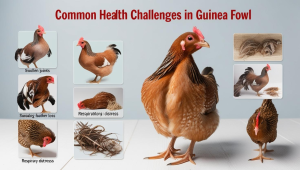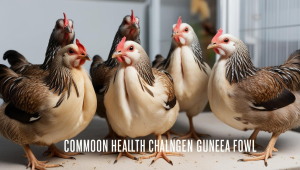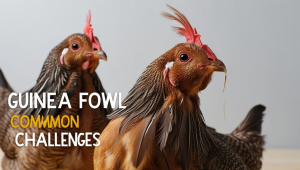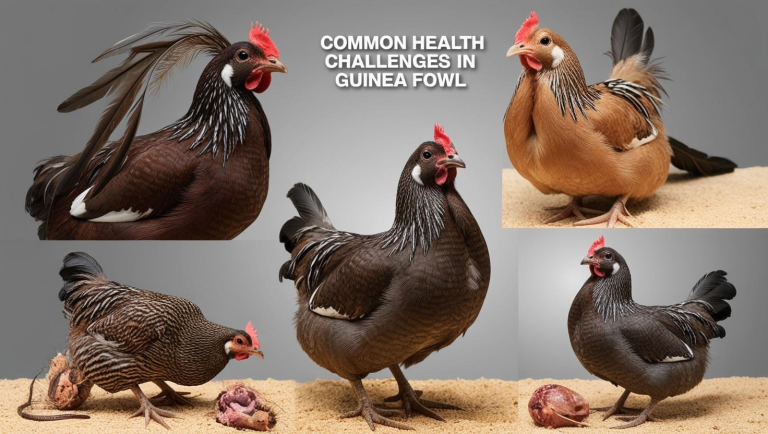Guinea fowl are hardy birds known for their strong immune systems and resilience to many poultry diseases. However, they are not completely immune to health issues. Poor management, nutritional deficiencies, environmental stressors, and infectious diseases can affect their well-being, productivity, and survival rates.
Understanding the common health challenges in guinea fowl, their symptoms, prevention, and treatment methods can help farmers maintain a healthy flock and maximize production. This article explores the most prevalent health issues affecting guinea fowl and best practices for disease control and flock management.
Click HERE to join our WhatsApp group
Common Diseases in Guinea Fowl
a) Newcastle Disease (ND)
Cause: Viral infection caused by paramyxovirus.
Symptoms:
Respiratory distress (coughing, gasping, sneezing)
Greenish diarrhea
Twisting of the neck (torticollis)
Paralysis
Reduced egg production
Prevention & Control:
Vaccination at an early age
Proper sanitation and biosecurity measures
Isolation of infected birds
READ ALSO: Pig Feed Formulation and Nutritional Requirements
b) Fowl Pox
Cause: Avian poxvirus, transmitted through mosquitoes and direct contact.
Symptoms:
Scabby lesions on the comb, wattles, and around the eyes (dry form)
Lesions in the mouth and respiratory tract (wet form)
Reduced growth and egg production
Prevention & Control:
Vaccination
Mosquito control in the environment
Proper sanitation and disinfection
c) Coccidiosis
Cause: Parasitic infection caused by Eimeria protozoa.
Symptoms:
Blood in droppings
Weight loss and weakness
Decreased appetite
Ruffled feathers
Prevention & Control:
Use of coccidiostats in feed
Keeping litter dry and clean
Rotational grazing for free-range flocks
READ ALSO: Dairy Farming: Best Practices for High Milk Yield
d) Marek’s Disease
Cause: Herpesvirus affecting the nervous system.
Symptoms:
Paralysis of wings and legs
Weight loss
Tumors in internal organs
Prevention & Control:
Vaccination at the hatchery
Maintaining proper hygiene
e) Aspergillosis
Cause: Fungal infection caused by Aspergillus spp.
Symptoms:
Respiratory distress
Open-mouth breathing
Weakness and lethargy
Prevention & Control:
Avoid moldy feed and bedding
Ensure good ventilation
Use antifungal treatments if necessary
Parasitic Infections

a) External Parasites (Mites, Lice, and Ticks)
Symptoms:
Feather loss
Skin irritation and scratching
Reduced egg production
Prevention & Control:
Regular dust baths
Use of diatomaceous earth or poultry-safe insecticides
Cleaning and disinfecting coops
READ ALSO: Alternative Feed Ingredients and Their Benefits
b) Internal Parasites (Worms)
Symptoms:
Weight loss
Diarrhea
Lethargy
Prevention & Control:
Routine deworming
Keeping litter dry and clean
Avoiding overcrowding
Nutritional Deficiencies and Disorders

a) Vitamin A Deficiency
Symptoms:
Poor growth
Eye discharge and swollen eyelids
Weak immune system
Prevention & Control:
Provide leafy greens, carrots, and vitamin supplements
b) Calcium Deficiency (Rickets)
Symptoms:
Soft or thin eggshells
Weak legs and bone deformities
Prevention & Control:
Supplement with crushed oyster shells or limestone
c) Protein Deficiency
Symptoms:
Slow growth
Feather pecking and cannibalism
Poor egg production
Prevention & Control:
Provide high-protein feed (16-22% protein)
Include mealworms, fish meal, or soybean meal in the diet
READ ALSO: Energy Sources in Poultry Diets
Environmental and Management-Related Issues
a) Heat Stress
Symptoms:
Panting and open-mouth breathing
Reduced feed intake
Weakness and death in extreme cases
Prevention & Control:
Provide shade and cool water
Proper ventilation in housing
Reduce stocking density
b) Cold Stress
Symptoms:
Huddling together
Reduced egg laying
Frostbite on combs and wattles
Prevention & Control:
Provide warm shelters during winter
Use deep litter bedding
Biosecurity Measures for Guinea Fowl Health

Quarantine New Birds: Prevent the introduction of diseases.
Regular Cleaning: Disinfect feeders, waterers, and coops.
Limit Visitors: Prevent disease transmission from outside sources.
Proper Waste Management: Dispose of droppings and bedding properly.
Conclusion
Guinea fowls are relatively hardy birds but still require proper health management to thrive. By understanding common health challenges, implementing disease prevention measures, and ensuring a balanced diet, farmers can maintain a productive and healthy flock.
READ ALSO: The Role of Water in Livestock Production
Water is an essential component of livestock production, playing a crucial role in maintaining animal health, ensuring optimal growth, and sustaining agricultural operations. As one of the most critical resources in livestock farming, water directly impacts productivity, feed efficiency, and overall farm sustainability. This article explores the multifaceted role of water in livestock production, covering its importance in animal physiology, feed digestion, hygiene, and environmental sustainability…
READ ALSO: Introduction to Organic Livestock Farming
Organic livestock farming is an agricultural system that emphasizes sustainable, ethical, and environmentally friendly practices in raising animals for meat, dairy, eggs, and other animal-based products. This approach focuses on natural methods of animal husbandry, ensuring high welfare standards, prohibiting synthetic chemicals, and minimizing environmental impact. Organic farming promotes biodiversity, soil health, and…
Click HERE to join our WhatsApp group

